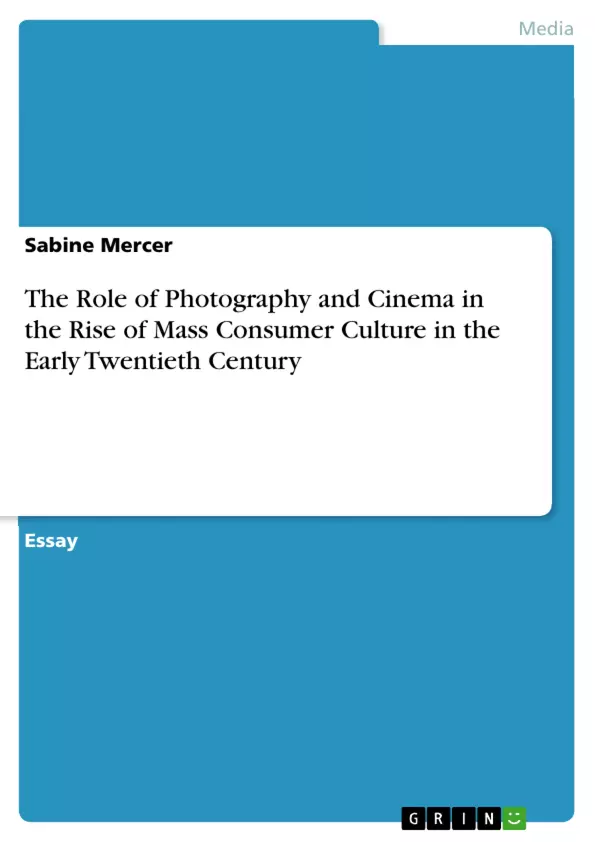The Industrial Revolution was characterized by two intrinsically linked social phenomena. Firstly, a social shift in the transformation of a traditionally agricultural society into an industrial and increasingly urban mass society; secondly, a technological shift resulting in the virtual explosion of the mass production of consumer goods. Towards the end of the nineteenth century these two events, large-scale changes in social structure and mass production, became the basis for the rise of consumer capitalism.
This newly generated consumer market was made possible by a steady increase in mass production, characterized by large numbers of diversified goods, often with a built-in obsolescence, which stimulated the process of ongoing consumption. The need for a frequent replacement of commodities, in combination with the striving of urbanised individuals to fill the gaping void within his or her existence that resulted from the demotion of labour productivity in the framework of modern society, gave rise to consumer culture.
Inhaltsverzeichnis (Table of Contents)
- INTRODUCTION
- 1. The Rise of Consumer Culture and the Making of the Individual
- 2. The Shaping of the Modern Consumer Culture
- 3. Creating a Life-Style: “Born to Buy”
- 4. Psychology in Advertising: Establishing and Maintaining the Social Self
- 5. The Role of Photography in Advertising
- 6. The Role of Cinema in Advertising
- 7. Celebrity Endorsement Advertising
- 8. Branding as a Marketing Strategy
- 9. Ideology in Advertising
- CONCLUSION
Zielsetzung und Themenschwerpunkte (Objectives and Key Themes)
This essay examines the rise of consumer culture in the early twentieth century, exploring how it emerged from the Industrial Revolution and the development of mass production and mass media. It investigates the role of advertising in shaping consumer desires and identities, and how this industry employed various media channels, particularly photography and cinema, to promote products and ideologies.
- The impact of the Industrial Revolution on social and technological change
- The emergence of consumer capitalism and the role of mass production
- The development of advertising as a key force in shaping consumer culture
- The use of media, particularly photography and cinema, in advertising
- The influence of consumerism on individual identities and social relationships
Zusammenfassung der Kapitel (Chapter Summaries)
- Introduction: This chapter sets the stage for the essay by outlining the rise of consumer culture as a consequence of the Industrial Revolution and mass production. It discusses the role of advertising in shaping consumer desires and identities, and how this industry utilized various media channels to promote products and ideologies.
- The Rise of Consumer Culture and the Making of the Individual: This chapter explores the social and economic shifts that led to the emergence of a new commodity culture in the late nineteenth century. It highlights the alienation and insecurity experienced by individuals in the rapidly urbanizing and industrializing world, and how consumer goods offered a means of establishing and expressing identity within a mass society.
- The Shaping of the Modern Consumer Culture: This chapter examines the development of advertising as a powerful force in shaping consumer behavior and promoting consumption. It discusses the use of media, particularly photography and cinema, to create idealized images of products and lifestyles that appeal to consumers.
- Creating a Life-Style: “Born to Buy”: This chapter delves deeper into the role of advertising in constructing consumer lifestyles and identities. It explores how advertising perpetuates stereotyped gender roles and traditional family values, and how it connects product use with desirable social status and personal fulfillment.
- Psychology in Advertising: Establishing and Maintaining the Social Self: This chapter focuses on the psychological underpinnings of advertising and its effectiveness in influencing consumer behavior. It analyzes how advertising appeals to basic human needs and desires, such as the need for belonging, recognition, and self-esteem, and how it creates a sense of psychological dependence on consumption.
Schlüsselwörter (Keywords)
Consumer culture, advertising, mass production, mass media, Industrial Revolution, photography, cinema, consumerism, identity, social status, branding, ideology, fetishism.
- Quote paper
- Dr. Sabine Mercer (Author), 2006, The Role of Photography and Cinema in the Rise of Mass Consumer Culture in the Early Twentieth Century, Munich, GRIN Verlag, https://www.grin.com/document/300164



